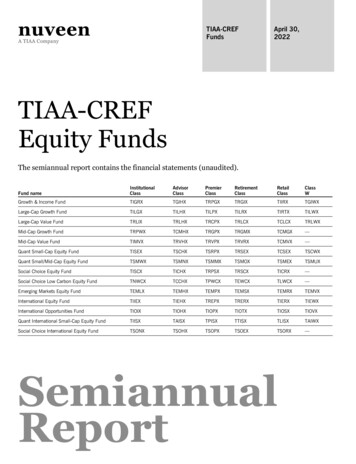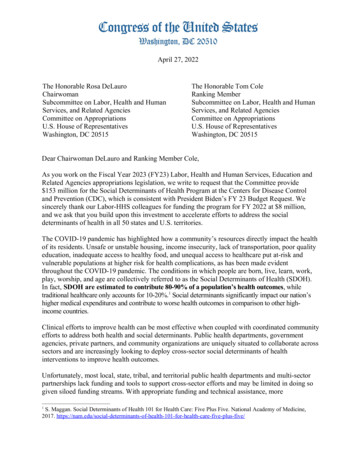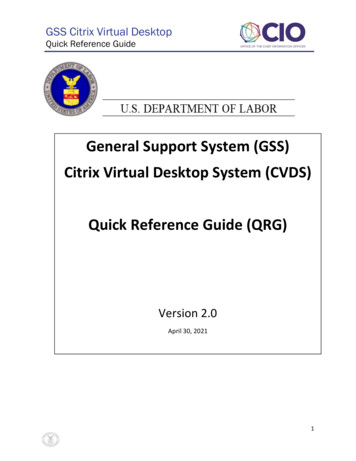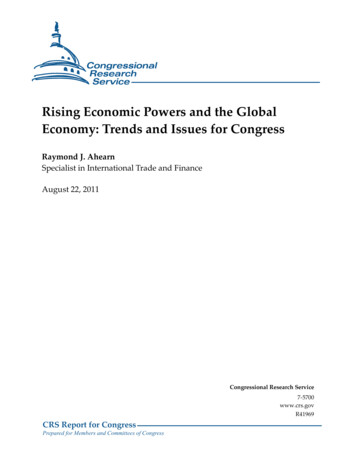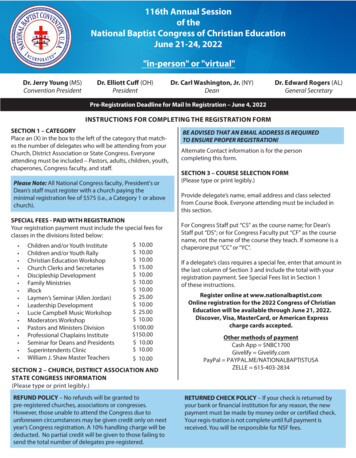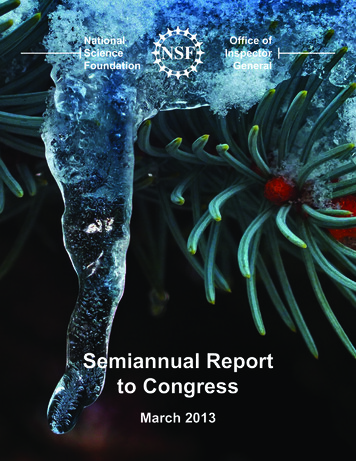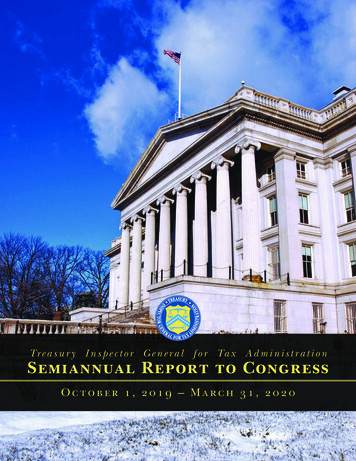
Transcription
Semiannual Report to CongressOffice of Inspector General for the U.S. Department of LaborVolume 68April 1– September 30, 2012
A Message from the Deputy Inspector GeneralI am pleased to submit this Semiannual Report to Congress, which highlights the most significant activities and accomplishmentsof the U.S. Department of Labor (DOL), Office of Inspector General (OIG) for the six-month period ending September 30, 2012. Ouraudits and investigations continue to assess the effectiveness, efficiency, economy, and integrity of DOL’s programs and operations.We also continue to investigate the influence of labor racketeering and/or organized crime with respect to internal union affairs,employee benefit plans, and labor-management relations.During this reporting period, we issued 41 audit and other reports that, among other things, recommended that 297 million infunds be put to better use. Among our many significant findings, we reported that: The use of limited-scope audits by independent public accountants that are authorized under the Employee Retirement IncomeSecurity Act (ERISA) allowed 3.3 trillion in assets to be excluded from audit review. Management of the H-2B visa program needed to be strengthened to ensure adequate wage and job protections for U.S. workers. Oversight of Job Corps centers’ performance needed to be improved to ensure that centers meet performance goals relatingto academic and career technical training programs. OSHA site specific inspection targeting program covered only a small portion of high-risk worksites nationwide. Bureau of Labor Statistics’ requirements designed to protect confidential economic data and statistics from being disclosedprematurely or used in an unauthorized manner were violated in North Carolina, Wisconsin, Washington, and Louisiana. Corrective actions taken as a result of the Mine Safety and Health Administration’s accountability reviews did not alwaysprevent the recurrence of deficiencies, such as the failure to conduct safety and health inspections for all working shifts atmetal/nonmetal mines.Our investigative work also yielded impressive results, with a total of 357 indictments, 230 convictions, and 141.5 million inmonetary accomplishments. Some of our investigative results included: The sentencing of the former benefit fund administrator for the New York Laborers’ International Union of North America(Sandhogs’ Union) Local 147 to six years in prison and three years of supervised release for her role in embezzling more than 40 million from employee benefit plans. The sentencing of a former county commissioner in Ohio to 28 years in prison for his role in multiple crimes including racketeering,bribery, and conspiracy. The sentencing of the former president of the United Food and Commercial Workers (UFCW) Northeastern District Councilin Pennsylvania to 18 months in prison and to pay more than 257,000 in restitution for embezzling from labor union assetsand from a health care benefit program. The sentencing of an individual in Florida to more than two years in prison and ordered to pay nearly 2 million in restitutionfor her role in an illicit nationwide employee leasing scheme. The guilty plea of a New York construction company owner, who agreed to repay more than 1.3 million in prevailing wagesowed to his workers.These examples clearly demonstrate the exceptional work done by our professional and dedicated OIG staff. I would like to expressmy gratitude to them for their significant achievements during this reporting period. I look forward to continuing to work with theDepartment to ensure the integrity of programs and the protection of the rights and benefits of workers and retirees.Daniel R. PetroleDeputy Inspector General
Selected Statistics . . . . . . . . . . . . . . . . . . . . . . . . . . . . . . . . . . . . . . . . . . . . 2Significant Concerns . . . . . . . . . . . . . . . . . . . . . . . . . . . . . . . . . . . . . . . . . . 3ContentsEmployment and Training ProgramsForeign Labor Certification Programs . . . . . . . . . . . . . . . . . . . . . . . . . . . . . . 8Workforce Investment Act. . . . . . . . . . . . . . . . . . . . . . . . . . . . . . . . . . . . . . 11Job Corps . . . . . . . . . . . . . . . . . . . . . . . . . . . . . . . . . . . . . . . . . . . . . . . . . . . . 13Bureau of Labor Statistics. . . . . . . . . . . . . . . . . . . . . . . . . . . . . . . . . . . . . . . 15Worker Safety, Health, and Workplace RightsMine Safety and Health Administration . . . . . . . . . . . . . . . . . . . . . . . . . . . 18Occupational Safety and Health Administration. . . . . . . . . . . . . . . . . . . . . 20Wage and Hour Programs. . . . . . . . . . . . . . . . . . . . . . . . . . . . . . . . . . . . . . . 22Worker and Retiree Benefit ProgramsOffice of Workers’ Compensation Programs. . . . . . . . . . . . . . . . . . . . . . . . 26Unemployment Insurance Programs. . . . . . . . . . . . . . . . . . . . . . . . . . . . . . 29Employee Benefit Plans . . . . . . . . . . . . . . . . . . . . . . . . . . . . . . . . . . . . . . . . 34Office of Labor-Management Standards. . . . . . . . . . . . . . . . . . . . . . . . . . . 36Disadvantaged Business Enterprises. . . . . . . . . . . . . . . . . . . . . . . . . . . . . . 37Labor RacketeeringBenefit Plan Investigations . . . . . . . . . . . . . . . . . . . . . . . . . . . . . . . . . . . . . . 41Internal Union Corruption Investigations. . . . . . . . . . . . . . . . . . . . . . . . . . 43Labor-Management Investigations . . . . . . . . . . . . . . . . . . . . . . . . . . . . . . . 45Departmental Management. . . . . . . . . . . . . . . . . . . . . . . . . . . . . . . . . . . 48Single Audits. . . . . . . . . . . . . . . . . . . . . . . . . . . . . . . . . . . . . . . . . . . . . . . . . . 49Employee Integrity Investigations. . . . . . . . . . . . . . . . . . . . . . . . . . . . . . . . 50Legislative Recommendations . . . . . . . . . . . . . . . . . . . . . . . . . . . . . . . . . 52Appendices. . . . . . . . . . . . . . . . . . . . . . . . . . . . . . . . . . . . . . . . . . . . . . . . . 57Semiannual Report to Congress: April 1– September 30, 2012
Selected StatisticsInvestigative recoveries, cost-efficiencies, restitutions,fines and penalties, forfeitures, and civil monetary action. 141.5 millionInvestigative cases opened. 253Investigative cases closed. 223Investigative cases referred for prosecution. 261Investigative cases referred for administrative/civil action. 101Indictments. 357Convictions. 230Debarments. 48Audit and other reports issued. 41Funds recommended for better use. 297 millionOutstanding questioned costs resolved during this period. 6.9 millionAllowed1. 1.8 millionDisallowed2. 5.1 million122Allowed means a questioned cost that DOL has not sustained.Disallowed means a questioned cost that DOL has sustained or has agreed should not be charged to the government.Semiannual Report to Congress: April 1– September 30, 2012
Significant ConcernsThe OIG works with the Department and Congress to provide information and recommendations that will be usefulin their management or oversight of the Department. The OIG has identified areas that we consider particularlyvulnerable to mismanagement, error, fraud, waste, or abuse. These issues form the basis of our annual Top ManagementChallenges report required under the Reports Consolidation Act of 2000. The Top Management Challenges report canbe found in its entirety in the Appendix of this report.Protecting the Safety and Health ofWorkersThe OIG remains concerned with the effectiveness ofDepartmental programs in protecting the safety and healthof our nation’s workers. Specifically, audit findings continueto raise concerns with the ability of the OccupationalHealth and Safety Administration (OSHA) to best targetits resources to the highest-risk worksites nationwide andto measure the impact of its policies and programs —and those of the 27 states authorized by OSHA to operatetheir own safety and health programs. OSHA carries outits enforcement responsibilities through a combination ofself‐initiated and complaint investigations, but can reachonly a fraction of the entities it regulates. Consequently,OSHA must strive to target the most egregious andpersistent violators and protect the most vulnerableworker populations.Protecting the Safety and Health of MinersSimilarly, the OIG is concerned with the ability of the MineSafety and Health Administration (MSHA) to effectivelymanage its resources to meet statutory mine inspectionrequirements while successfully accomplishing otheressential functions to help ensure that every miner returnshome safely at the end of each day. Our audits have shownthat MSHA remains challenged to maintain a cadre ofexperienced and properly trained enforcement staff tomeet its statutory enforcement obligations. MSHA alsofaces challenges in establishing a successful accountabilityprogram, and to some degree, deficiencies continue torecur. In addition, as scientific knowledge and miningpractices change, MSHA must promote the developmentand use of new technologies and ensure that its standardsand regulations keep pace.Improving Performance Accountability ofWorkforce Investment Act GrantsAnother area of concern for the OIG is the Department’sability to ensure that the Workforce Investment Act(WIA) grant programs are successful in training andplacing workers in suitable employment to reducechronic unemployment, underemployment, and relianceon social payments by the population it serves. Ouraudit work over several decades has documented thedifficulties encountered by the Department in obtainingquality employment and training providers; ensuringthat performance expectations are clear to granteesand sub-grantees; obtaining accurate and reliable databy which to measure and assess the success of granteesand states in meeting the program’s goals; providingactive oversight of the grant making and grant executionprocess; disseminating proven strategies and programsfor replication; and, most critically, ensuring that trainingprovided by grantees leads to placement in related jobspaying a living wage.Semiannual Report to Congress: April 1– September 30, 20123
Significant ConcernsEnsuring the Effectiveness of the JobCorps ProgramThe Job Corps program’s administrative policies and itsability to manage contracts and subcontracts is also aconcern for the OIG. The Department is challenged toprovide a safe, residential and nonresidential educationand training program which results in outcomes thattruly assist at-risk, disadvantaged youth (ages 16-24) inturning their lives around, including: placement in trainingrelated employment, entrance into advanced vocational/apprenticeship training, entrance into higher education,or enlistment in the military. Our audits have consistentlydocumented the Department’s difficulty in ensuring thequality of residential life, a critical component of the JobCorps’ intensive intervention experience. Our audits havealso demonstrated the challenge faced by the Departmentin obtaining and documenting desired program outcomes.Reducing Improper PaymentsThe Department’s ability to identify and reduce the rateof improper payments in the Unemployment Insurance(UI), FECA and WIA programs is a continuing concern forthe OIG. In the UI program, our audits have found that theDepartment lacked effective controls over the detectionof improper payments, and that the Department’sestimate of recoverable payments may be understated.In addition, OIG investigations continue to uncover fraudcommitted by individual UI recipients who do not report orunderreport earnings, as well as fraud related to fictitiousemployer schemes. Similarly, we remain concerned withthe Department’s ability to identify the full extent ofimproper payments in the WIA and FECA programs. Ashighlighted in past OIG audits, the estimation methodused for the FECA program does not appear to provide areasonable estimate of improper payments. In addition,OIG investigations continue to identify high amounts ofFECA compensation and medical fraud, which has oftengreatly surpassed the Department’s improper paymentsestimates. For the WIA program, we have noted that data4Semiannual Report to Congress: April 1– September 30, 2012were not readily available to allow the Department todirectly sample grant payments to develop a statisticallyvalid estimate of improper payments.Maintaining the Integrity of Foreign LaborCertification ProgramsAnother area of concern is the Department’s ability toprovide U.S. businesses access to foreign workers to meettheir workforce needs while protecting the jobs and wagesof U.S. workers. Our audits have found that statutory limitson the Department’s authority, and uncertainty regardingthe process for including individuals or entities debarredon the government-wide excluded parties lists are someof the issues that have negatively impacted the H-1Bprogram. For the H‐2B program, we have found that DOLregulations have hampered the Department’s ability toprovide adequate protections for U.S. workers becausethe system is based on a model where employers merelyassert, but do not demonstrate, that they have performedan adequate test of the U.S. labor market before hiringforeign workers. The Department published a newrule that addresses the concern by requiring review ofemployers’ documentation before it issues certificationdeterminations; however, due to pending legal actions,the Department continues to operate under the oldregulations. OIG investigations also continue to uncovercomplex schemes involving fraudulent DOL FLC documentsfiled in conjunction with or in support of similarly falsifiedidentification documents required by other Federal andstate organizations.
Significant ConcernsEnsuring the Security of Employee BenefitPlan AssetsThe Employee Benefits Security Administration’s (EBSA)limited authority and resources present challenges toachieving its mission of administering and enforcingERISA requirements for an estimated 5.3 million employeebenefit plans covering approximately 141 millionparticipants and beneficiaries. Chief among our concernsover the past couple of decades has been the fact thatmillions in pension assets held in otherwise regulatedentities, such as banks, escape audit scrutiny because oflimited scope audits authorized under ERISA, which resultin no opinion on the financial status of the plan by theindependent public accountants that conduct the limitedreview. These concerns were renewed and heightenedby recent audit findings that as much as 3.3 trillion inpension assets received these types of no opinion audits,providing no assurances to participants as to the financialhealth of their plans.EBSA is further challenged by the many changes that havetaken place in the employee benefit plan communitysince ERISA was enacted in 1974, such as the shift fromdefined benefit retirement plans to defined contributionretirement plans; the large increase in the types andcomplexity of investment products available to pensionplans; and the new health care law. In addition, uncertaintyabout the effectiveness of EBSA enforcement programson ERISA compliance makes it difficult for EBSA to directits limited resources effectively among its regional officesto the enforcement areas where they would do the mostgood.Securing Information Technology Systemsand Protecting Related Information AssetsSafeguarding information assets is a continuing concern forFederal agencies, including DOL. The Administration’s goalof expanding the use of technology to create and maintainan open and transparent government, while safeguardingsystems and protecting sensitive information, has addedto the challenge. Recent OIG audits have identified accesscontrols, background investigations, and oversight of thirdparties involved in the operation and support of IT systemsas significant deficiencies. In addition, we have identifiedmajor weaknesses in the process of sanitizing electronicmedia prior to it being removed from DOL’s control anddestroyed.Ensuring the Effectiveness of Veterans’Employment and Training ProgramsProviding meaningful employment and training servicesto military veterans and members transitioning to civilianemployment remains a challenge for the Department.Our audits have found that the Department needs to do abetter job of accurately assessing the veterans’ needs anddocumenting intensive service activities — particularly forhomeless veterans with disabilities. We have also foundthat Veterans’ Employment and Training Service (VETS)did not use measurable performance goals and outcomesto evaluate program effectiveness and lacked adequatecontracting oversight for Transition Assistance Program(TAP) workshop services. These deficiencies underminedVETS’s ability to ensure that it was providing a high-qualityprogram that helps veterans successfully transition frommilitary to civilian employment.Improving Procurement IntegrityEnsuring the integrity of the Department’s procurementactivities is also of concern for the OIG. Until procurementand programmatic responsibilities are properly separatedand effective controls are put into place, DOL will continueto be at risk for wasteful and abusive procurementpractices. Our most recent audits and investigationsof DOL’s procurement activities identified the need forbetter control and monitoring of procurement activitiesdelegated to program agencies.Semiannual Report to Congress: April 1– September 30, 20125
Employment and TrainingProgramsSemiannual Report to Congress, Volume 62
Employment and Training ProgramsForeign Labor Certification ProgramsThe Employment and Training Administration (ETA) administers a number of foreign labor certification (FLC)programs that allow U.S. employers to employ foreign workers to meet American worker shortages. The H-1B visaspecialty workers’ program requires employers that intend to employ foreign specialty-occupation workers on atemporary basis to file labor condition applications with ETA stating that appropriate wage rates will be paid andthat workplace guidelines will be followed. The H-2B program establishes a means for U.S. nonagricultural employersto bring foreign workers into the United States to meet temporary worker shortages. The Permanent Foreign LaborCertification program allows an employer to hire a foreign worker to work permanently in the United States.H-2B Program Needs to be Strengthenedto Ensure Adequate Protections for U.S.WorkersTo obtain H-2B certification and comply with employmentprotections, employers must self-attest that U.S. workerscapable of performing the job are not available and that theemployment of foreign workers will not adversely affectthe wages and working conditions of similarly employedU.S. workers. The OIG conducted a performance auditof the H-2B program to determine if ETA’s managementof the H-2B program ensured adequate protections forU.S. workers. This expanded on a 2011 audit of the H-2Bprogram focusing on forestry employers in Oregon. Wereviewed H-2B applications for 33 employers in six statesin order to determine if the attestations made on theirrespective applications could be supported and if ETAadhered to current program regulations.Our audit found that ETA’s management of the H-2Bprogram needed to be strengthened to ensure adequateprotections for U.S. workers. Of the 33 employers thatwere reviewed, 27 could not support the attestationsmade on their applications, such as those related to prefiling recruitment. While ETA began conducting postadjudication audits in 2009 to verify the accuracy of theapplications and ensure integrity within the H-2B program,the audits were typically initiated six months after the8Semiannual Report to Congress: April 1– September 30, 2012foreign workers’ employment period ended and took up to120 days to complete. Because of the timing and durationof the audits, an employer could potentially file and receivea new certification for a subsequent application before ETArendered a decision of compliance/non-compliance for aprevious application.ETA issued a Final Rule in February 2012 that would replacethe self-attestation model with a compliance-basedformat, which would require the review of documentationprovided to ETA in advance of ETA making the certificationdetermination. However, the rule has been challenged incourt and has not been implemented.We made four recommendations to ETA: (1) to reviewpayroll source documentation when conductingpost-adjudication audits; (2) to collaborate with theDepartment of Homeland Security to explore ways forETA to review U.S. Citizenship and Immigration Servicesdocuments during post-adjudication audits; (3) to beginpost-adjudication audits no later than 120 days into theapproved employment period of the selected applicationand complete within 70 days; and (4) to continue pursuingregulatory action and explore other ways to ensure theintegrity of the program – including, but not limited to,legislative changes designed to expand ETA’s pre-approvalvalidation authority. ETA generally agreed with three ofthe recommendations. The OIG modified the fourth
Employment and Training Programsrecommendation to incorporate an ETA concern: for ETAto seek regulatory changes to ensure the integrity of theH-2B program. (Report No. 06-12-001-03-321, September28, 2012)Fugitive Extradited from Italy Sentencedin Employee Leasing SchemeLucia Kanis was sentenced on April 18, 2012, to morethan two years in prison and ordered to pay nearly 2 million in restitution in connection with her role in anillicit nationwide employee-leasing scheme. Kanis, whohad fled to Slovakia before charges were brought againsther in 2005, was arrested in Bologna, Italy, on May 16,2011, and was extradited to the United States to faceprosecution for conspiring to defraud the United Statesand evading taxes.From 1995 through January 2005, Kanis and her codefendants arranged for more than 550 undocumentedforeign nationals to work in several industries inthe midwest and southeastern United States. Thedefendants, who had set up entities to act as employeeleasing companies, contracted with legitimate Americancompanies to provide them legally authorized workers.Instead, the defendants provided workers lacking legalwork status, and failed to pay applicable Federal payrolland unemployment taxes on behalf of the employees. Thelast remaining defendant has been charged but remains afugitive. All other defendants have pled guilty.This was a joint investigation with Immigration andCustoms Enforcement (ICE) and Internal Revenue Service– Criminal Investigative Division (IRS-CID), along withassistance from the Italian Ministry of Justice. UnitedStates v. Lucia Kanis (S.D. Florida)Manpower Supply Company OwnerSentenced for Role in Visa Fraud SchemeYoo Taik Kim, owner of Hi-Cap Enterprises, a manpowersupply company, was sentenced on April 19, 2012, tomore than three years in prison, three years of supervisedrelease, and was ordered to pay a fine of 125,000 for hisrole in a visa fraud scheme. Kim had previously been foundguilty of visa fraud, making false statements, and unlawfulprocurement of citizenship. Kim, who is a naturalized U.S.citizen, was stripped of his citizenship as a result of hisconviction and for lying on his citizenship application. Hewill also face possible deportation to his native country ofKorea upon completion of his sentence.Through his company, Kim contracted with a corporationto provide temporary workers for a large constructionproject in northern California. Although he had beennotified by the corporation that its labor needs haddwindled, making further recruitment unnecessary, in2001, unbeknownst to the corporation, Kim continued torecruit on its behalf, bringing a total of 49 welders fromThailand to San Francisco. The corporation ultimately hired10 of the welders. Kim and his associates transported theremaining 39 workers to southern California, where theylived in substandard conditions in apartments providedby Kim’s company. With no source of income and facingpotential arrest and deportation for being in violationof their visas, the workers survived by working for littleor no pay in two Thai restaurants owned by Kim. Manyof the workers, who were recruited from some of thepoorest areas of Thailand, had secured loans from familyand friends to pay their travel expenses and substantialrecruitment fees associated with their coming to work inthe United States. These payments were made to a Thairecruitment agency working with Kim’s company.This was a joint investigation with ICE. United States v. YooTaik Kim (C.D. California)Semiannual Report to Congress: April 1– September 30, 20129
Employment and Training ProgramsForeign National Sentenced for Visa FraudSrinivas Doppalapudi, owner of an employment leasingcompany, was sentenced on September 26, 2012, to morethan one year in prison for his role in an H-1B visa fraudscheme. He had previously pled guilty to visa fraud andmoney laundering, and had agreed to forfeit 345,000 inproceeds from the fraud.From April 2008 through December 2010, Doppalapudisubmitted 31 fraudulent H-1B visa applications fornon-existent information technology positions with hisemployment leasing company. As part of the scheme,he created fictitious service contracts with forgedsignatures. After the foreign nationals received their visas,Doppalapudi did not employ them. Some of the foreignnationals were able to find jobs in the IT industry; however,Doppalapudi further exploited them by requiring thatthey pay him 25 percent of their salaries since he was theholder of their H-1B visas. Doppalapudi transferred morethan 1 million derived as a result of this scheme to hispersonal bank account in India.This was a joint investigation with the IRS-CID, ICE, and theUnited States Citizenship and Immigration Service – Officeof Fraud Detection and National Security. United States v.Srinivas Doppalapudi (D. Delaware)Lawyer Pleads Guilty to MassiveImmigration FraudEarl Seth David, an immigration lawyer, pled guilty on April2, 2012, to conspiracy to commit immigration, mail, andwire fraud. As part of his plea, David agreed to forfeit atleast 2.5 million in proceeds from the scheme.From at least 1996 through 2011, David operated aManhattan-based immigration law firm that made millionsof dollars by filing thousands of false employment-basedlabor certification petitions with DOL. David conspired withother employees of his firm to solicit foreign nationals,10Semiannual Report to Congress: April 1– September 30, 2012some of whom paid up to 30,000 for false employmentsponsorships. David also paid dozens of business ownersto either use their businesses or personal identities tocreate shell companies in order to falsely represent toDOL that they were willing to or had legitimately hiredthese foreign nationals. David and his co-conspirators thenmanufactured letterhead used to produce fake experienceletters, asserting that the foreign nationals possessed thespecialized experience required for the jobs. He furtherenlisted the help of accountants to create counterfeit taxreturns for the fictitious sponsoring employers and bribeda former DOL contractor to manipulate information onDOL petitions. The vast majority of the more than 25,000immigration applications filed by David’s firm containedfraudulent information. As a result of this scheme, DOLissued thousands of labor certifications for David’s clientswho did not otherwise meet the legal requirements foremployment.In addition, Maritza Diaz, a former named partner withDavid’s law firm, was disbarred on August 7, 2012 forher role in the scheme and for pleading guilty to onecount of conspiring to commit immigration fraud. Otherconspirators who pled guilty include Mayor Weber,who pled guilty on September 28, 2012, and AlexandraUrbanek, who pled guilty on September 21, 2012. Inaddition, Andre Herbst and Chaim Walter each pledguilty on September 6, 2012, and Aryea Yehuda Flohr pledguilty on May 7, 2012. All pled to conspiracy to commitimmigration fraud in connection with their roles as allegedsponsoring employers. Twenty-five defendants have beencharged as part of the investigation – more than half havepled guilty.This is a joint investigation with ICE. United States v. EarlSeth David, et al. (S.D. New York)
Employment and Training ProgramsCalifornia Attorney Pleads Guilty to VisaFraud SchemeKelly Giles, a former California immigration attorney, pledguilty on September 13, 2012, to one count of conspiracyto commit visa fraud and one count of witness tamperingfor his role in an employment-based visa fraud scheme.Giles and his co-conspirators devised a scheme tofile at least 47 false employment-based immigrationpetitions with DOL and the United States Citizenship andImmigration Services. As
I am pleased to submit this Semiannual Report to Congress, which highlights the most significant activities and accomplishments of the U.S. Department of Labor (DOL), Office of Inspector General (OIG) for the six-month period ending September 30, 2012. Our audits and investigations continue to assess the effectiveness, efficiency, economy, and integrity of DOL's programs and operations.

